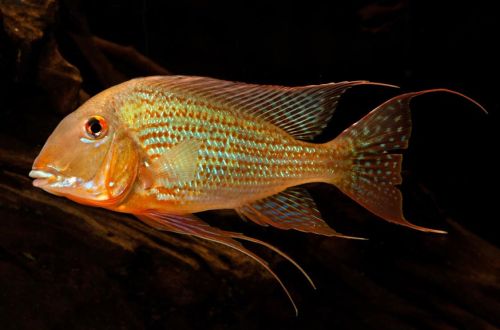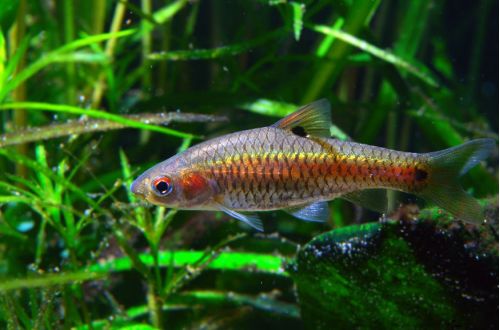
Danio Rerio
Danio rerio, scientific name Danio rerio, belongs to the Cyprinidae family. This is one of the first tropical fish species that was bred in aquariums for decorative purposes. Currently, the fish is one of the most popular species due to its original striped coloration, peaceful Narva and simple maintenance.

The fish is also known by the names “Zebrafish” and “Striped Danio”. Over the years, breeders have bred many artificial varieties that differ in color and size of fins. These varieties can successfully interbreed with each other, which leads to the emergence of new strains and blurring of the clear boundaries of existing ones.
The most famous artificial varieties of Danio Rerio are Danio Rerio albino, Leopard Danio, Golden Danio, Blue Danio. There is also a genetically modified strain that has a fluorescent element added to its genome, thanks to which the fish can glow in the dark. Such fish were called “Danio Glofish”. They first appeared commercially in the United States in 2003.

Requirements and conditions:
- The volume of the aquarium – from 40 liters.
- Temperature – 18-24°C
- Value pH — 6.0–8.0
- Water hardness – soft to medium hard (5-15 GH)
- Substrate type – dark fine gravel or sand
- Lighting – subdued or moderate
- Brackish water – no
- Water movement – moderate
- The size of the fish is up to 7 cm.
- Food – any food floating on the surface of the water
- Life expectancy – 3 to 4 years
Contents
Habitat
Danio Rerio received a scientific description in 1822 while studying the flora and fauna of the colonial possessions of the British Empire in the territories of modern India and Pakistan. Fish are widely represented in the river systems of Asia from Pakistan to India, including in Southeast Asia in Burma (Myanmar).

In the wild, the fish lives in the lower reaches of rivers, channels, canals, as well as in ditches near settlements and ponds. Habitat can vary greatly depending on the time of year. In the rainy season, as the water level rises, fish rush to flooded areas in river basins, where spawning takes place in a quiet backwater with dense vegetation. At the end of spawning, the fish return back to the main riverbeds. A few days later, after the adult fish, the fry that have appeared rush into the rivers.
Description
Beautiful slender fish. The classic coloration is pale yellow or silver with a pattern of horizontal stripes of dark blue. Stripes also run along the tail and anal fin.

As noted above, there are a large number of breeding varieties with a wide variety of colors: blue, yellow, red, orange, etc. In some cases, the loss of the striped body pattern occurred during selection.
Food
In the wild, fish feed on small zooplankton. In a home aquarium, Danio Rerio will accept most popular foods of a suitable size designed for feeding aquarium fish. It can be dry, fresh, frozen and live foods, such as bloodworms, brine shrimp, daphnia, etc.

It should be borne in mind that the fish mainly swim near the surface and in the water column, so the food should not immediately sink to the bottom, but stay on the water for some time. In this case, live or dry food is a good choice.
Maintenance and care, arrangement of the aquarium
Since the fish has been living in an artificial environment for many generations, it is well adapted to various habitat conditions. For this reason, Danio Rerio is considered an easy-to-keep fish.
For long-term care, it is enough to ensure good filtration and aeration of the aquarium. Both of these processes also create water movement, which is beneficial for the Danio.

It is recommended to replace part of the water with fresh weekly, combining this procedure with cleaning the soil with a siphon from accumulated organic waste.
The fish lives in the upper layers of the water and leads an active lifestyle, during their games they can jump out of the aquarium – take care of the protective cover.
The design of the aquarium is arbitrary and is selected at the discretion of the aquarist. However, the optimal choice is the presence of a large area for swimming and the presence of aquatic plants located along the side walls of the tank. Do not allow the aquarium to overgrow. It is noted that the dark ground and not too bright lighting emphasizes the color of the fish.
Behavior and Compatibility
Active peaceful fish, has a friendly disposition and never shows aggression towards other species. Joint keeping is possible with other Danio species, as well as with other peaceful fish of a comparable size.
A prerequisite is the maintenance of fish in a flock of at least 5 individuals. When kept alone or in pairs, the fish become slow, shy. Lack of social interaction with relatives negatively affects well-being.
Breeding / reproduction
Sexual differences are weakly expressed, females are only slightly larger than males, body color is the same in both sexes. Danio Rerio often forms couples that last a lifetime, but this is where the romanticism ends. Parental instincts are weakly expressed, they can eat their caviar with pleasure and do not participate in the care of their own offspring. Spawning requires a separate tank.
The spawning aquarium can be small, for example, 20-25 liters. The bottom should be strewn with balls with a diameter of 1 cm or gravel of a similar size. Arrange plants in dense groups. The composition of the water should be identical to the composition of the water in the general aquarium.

When it is noticed that two fish keep constantly together, and one of them has a swollen abdomen, it means that soon the female will lay eggs. The female is moved to a separate tank first. The male joins the next day. The stimulus for spawning is a rapid drop in water temperature by a couple of degrees, which is an imitation of the beginning of the rainy season. It is during this period that the fish begin to spawn in the wild.
More about breeding Danio
During breeding, the female releases eggs into the water, and the male fertilizes them. Sinking to the bottom, they roll into the spaces between the particles of the soil and become inaccessible to their parents. At the end of spawning, the couple is returned back to the common aquarium, and the fry appear after 7 days.
How to care for caviar and fry Danio
Diseases
Fish are very hardy, only a significant deterioration in living conditions or contact with sick fish can provoke a disease. For example, health problems can begin with prolonged exposure to hard water or in conditions of high levels of pollution. Also, the reason may be the lack of social communication when Danio lives alone. Read more about symptoms and treatments in the Aquarium Fish Diseases section.





